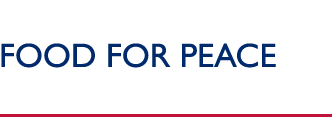 |
|
 |
 |
 |
 Introduction Introduction
Home
- List of Acronyms
- List of Cooperating Sponsors
- Conversion Tables
Part One
Section I:
Commodities
- Commodity Availability
- Commodity Characteristics
- References
Section II:
Food Commodity
Fact Sheets
- Beans, Black
- Beans, Great Northern
- Beans, Kidney (Light Red, Dark Red, All types)
- Beans, Navy (Pea Beans)
- Beans, Pink
- Beans, Pinto
- Beans, Small Red
- Bulgur (BW)
- Bulgur, Soy Fortified (SFBW)
- Corn (bagged, bulk)
- Cornmeal
- Cornmeal, Soy-Fortified (CMSF)
- Corn Soy Blend (CSB)
- Corn Soy Milk (CSM)
- Corn Soy Milk, Instant (ICSM)
- Lentils
- Non Fat Dry Milk (NFDM)
- Peas
- Rice
- Rice (Parboiled)
- Sorghum
- Sorghum Grits, Soy-Fortified (SFSG)
- Fortified Refined Vegetable Oil
- Wheat
- Wheat Flour
- Wheat Soy Blend (WSB)
- Wheat Soy Milk (WSM)
Section III:
Storage/Shelflife
Specifications
- Storage Specifications
- Storage Inspection Checklist
- Shelf Life of Agricultural Commodities
- References
Section IV:
Controlling
Damage to Food
Commodities
- Cleaning and Inspecting
- Insect Control
- Rodent Control
- Reference Chart for Controlling Damage to Food Commodities
- References
 Part Two Part Two
 An Overview An Overview
 Part Three Part Three
|
|
 |
 |
|
Section II: Commodity Fact Sheets |
 |
Updated January 2006
Sorghum
This
unprocessed whole grain is
consumed in parts of Asia and Africa. The most commonly used sorghum in
the Title II P.L. 480 program is yellow sorghum; however, white sorghum
is available in small quantities. Sorghum offers versatility for
processing into a variety of food products and is intended primarily
for distribution in emergency situations and in Food for Work programs
in those areas where sorghum is consumed.
1.
Nutritional Values (per 100 g)
These are average values, taken from the U.S. Department of
Agriculture, Agricultural Research Service (USDA:ARS) 2003 USDA
Nutrient Database, Release 16, Laboratory Home Page, (www.nal.usda.gov/fnic).
These nutrient values are provided as a guide for use in the
calculation of food aid rations; users should be aware that shipments
of food aid may vary from these exact values.
| Nutrient |
Amount |
Unit |
| Water |
9.20 |
g |
| Energy |
339 |
Kcal |
| Protein |
11.30 |
g |
| Total Lipid |
3.30 |
g |
| Carbohydrate |
74.63 |
g |
| Fiber,
total dietary |
n/a |
g |
| Ash |
1.57 |
g |
| Calcium |
28 |
mg |
| Iron |
4.40 |
mg |
| Magnesium |
n/a |
mg |
| Phosphorus |
287 |
mg |
| Potassium |
350 |
mg |
| Sodium |
6 |
mg |
| Zinc |
n/a |
mg |
| Copper |
n/a |
mg |
| Manganese |
n/a |
mg |
| Selenium |
n/a |
mcg |
| Vitamin C |
0 |
mg |
| Thiamin |
0.237 |
mg |
| Riboflavin |
0.142 |
mg |
| Niacin |
2.927 |
mg |
| Pantothenic acid |
n/a |
mg |
| Vitamin B-6 |
n/a |
mg |
| Folate |
n/a |
mcg |
| Vitamin
B-12 |
0 |
mcg |
| Vitamin A |
0 |
IU |
| Vitamin E |
0.00 |
mg-ATE |
| Vitamin D |
n/a |
IU |
| Iodine |
n/a |
mcg |
2.
Components: (per 100 g Sorghum)
100% Yellow or white grain sorghum grown in the United States.
3.
Specifications:
Class: Yellow or white. Dehulled or degermed.
Grade:
No. 2 or better
4.
Packaging:
50 kg (110.23 lb.) woven polypropylene bags. This fabric contains an
inhibitor to resist ultra-violet absorption along with an anti-skid
coating.
5.
Shelf Life:
At least one year. See "Section III:
Storage/Shelf Life Specifications" for more information.
Fact Sheet Download:
|


